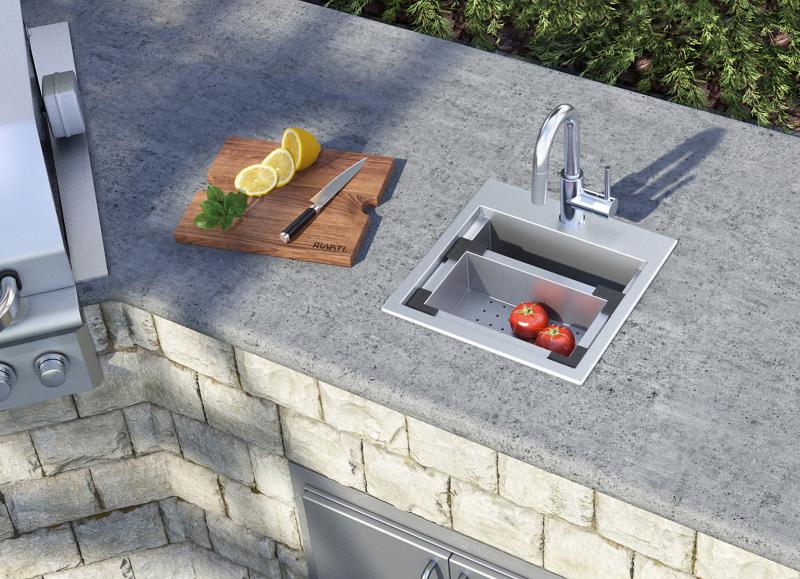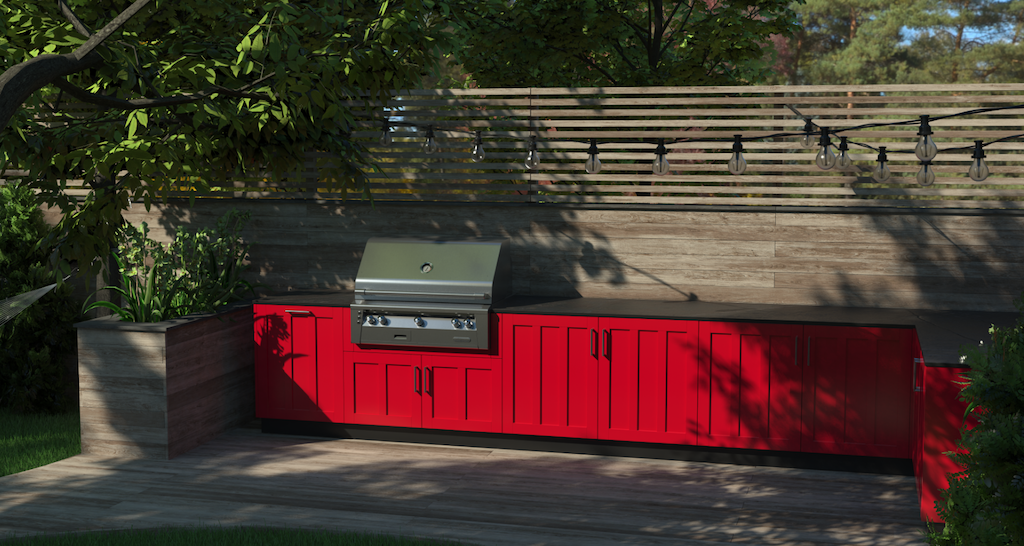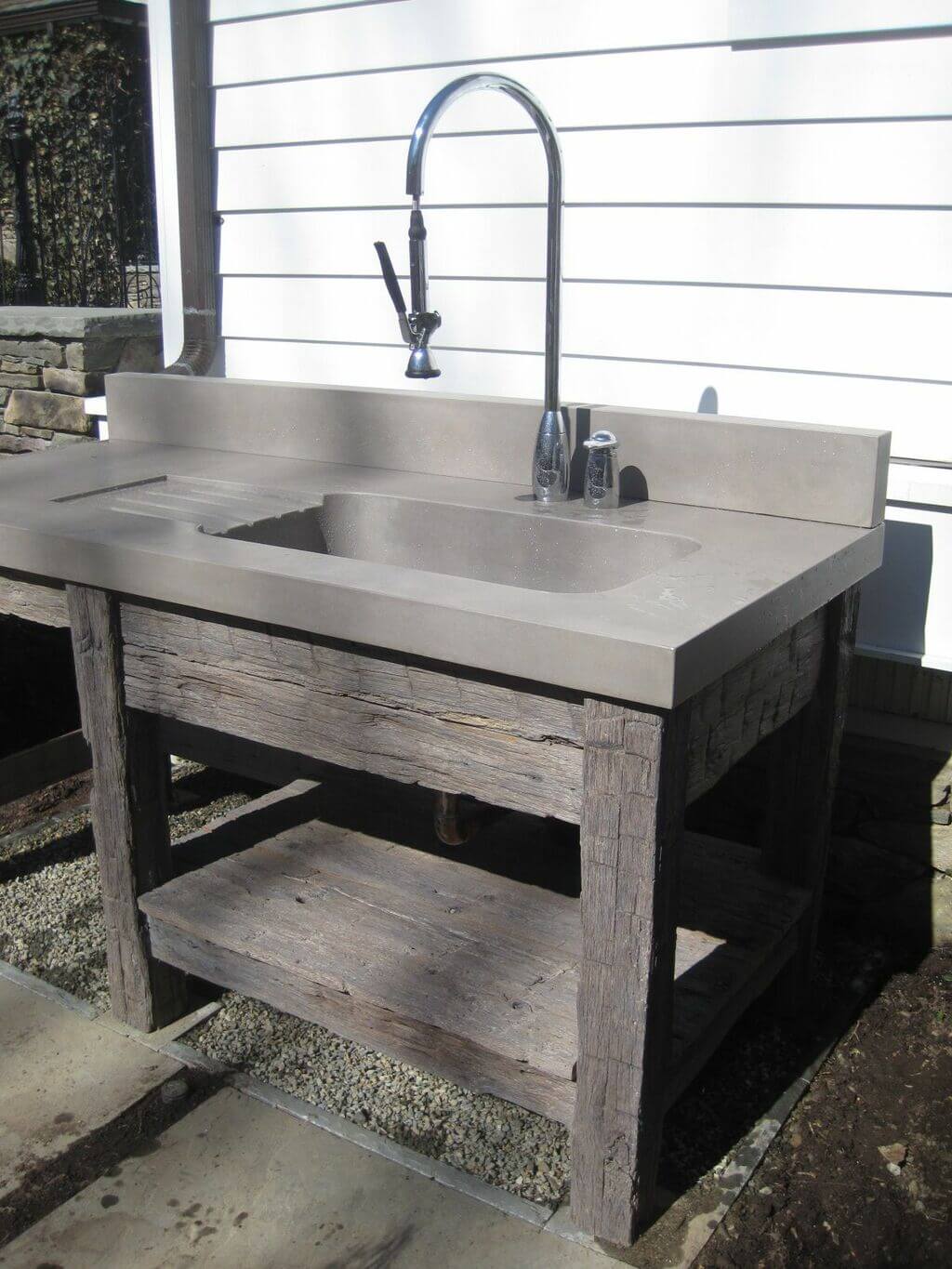Winter can be a challenging time for outdoor kitchens, especially when it comes to your sink. Freezing temperatures can cause pipes to burst and create a mess in your outdoor space. But fear not, there are steps you can take to prevent your outdoor kitchen sink from freezing and keep it functional all year round. One of the easiest ways to prevent your outdoor kitchen sink from freezing is by insulating the pipes. This can be done with foam pipe sleeves or heat tape. Make sure to cover all exposed pipes, including those under the sink and along the exterior walls. Another helpful tip is to keep the water running at a slow trickle. This will prevent the water from sitting in the pipes and freezing. You can also invest in a frost-free faucet that automatically shuts off when the temperature drops below freezing.1. How to Prevent Your Outdoor Kitchen Sink from Freezing
When choosing an outdoor kitchen sink for cold weather, it's important to consider the materials used. Stainless steel and granite composite sinks are a great option as they are durable and can withstand freezing temperatures. Avoid materials like porcelain or ceramic, which are more prone to cracking in extreme cold. Another factor to consider is the size of the sink. A larger sink with deeper basins will be less likely to freeze as there is more room for water to move and prevent stagnation. You can also opt for a sink with a built-in drainboard to help with water flow and prevent freezing.2. The Best Outdoor Kitchen Sinks for Cold Weather
Before the winter season hits, it's important to properly winterize your outdoor kitchen sink to prevent any damage. Start by draining all the water from the pipes and turning off the water supply. You can also add antifreeze to the pipes for an extra layer of protection. Make sure to also disconnect any hoses or attachments and store them in a dry place. Cover your sink with a weatherproof cover to protect it from the elements. And if you have a built-in refrigerator or ice maker, make sure to winterize them as well.3. Winterizing Your Outdoor Kitchen Sink: Tips and Tricks
In addition to insulating your pipes and winterizing your sink, there are other steps you can take to protect it from freezing temperatures. One option is to install a heat lamp or heat tape around the sink area. This will help keep the pipes warm and prevent them from freezing. You can also add a layer of mulch or straw around the base of your outdoor kitchen sink. This will act as insulation and help retain heat in the ground, keeping the pipes warmer. Just make sure to remove the mulch or straw in the spring to avoid any potential mold or mildew growth.4. Protecting Your Outdoor Kitchen Sink from Freezing Temperatures
If you plan on using your outdoor kitchen sink during the winter, it's important to properly insulate it to keep it functioning. You can do this by adding a layer of insulation under the sink, such as foam board or fiberglass insulation. This will help keep the area warm and prevent the pipes from freezing. Another option is to install a heated sink mat under the sink. These mats are specifically designed for outdoor use and will help keep the pipes warm and prevent freezing. You can also add a layer of insulation to the exterior walls surrounding the sink to further protect it from freezing temperatures.5. Insulating Your Outdoor Kitchen Sink for Winter Use
Living in a cold climate means that your outdoor kitchen sink needs to be able to withstand freezing temperatures and potential snow and ice buildup. When choosing materials for your sink, opt for ones that are durable and moisture-resistant. Stainless steel, granite composite, and stone are all great options for an outdoor kitchen sink in a cold climate. These materials are resistant to freezing temperatures and can handle the weight of snow and ice without cracking or breaking. Avoid materials like wood or tile, as they are more prone to damage in cold weather.6. Choosing the Right Materials for an Outdoor Kitchen Sink in a Cold Climate
If you find yourself with a frozen outdoor kitchen sink, there are a few steps you can take to thaw it out. First, try pouring hot water over the frozen pipes to help melt the ice. You can also use a hairdryer or heat gun on a low setting to gently warm up the pipes. If these methods don't work, you may need to call a professional plumber to help thaw out the pipes and prevent any potential damage. It's always better to be safe than sorry when it comes to frozen pipes.7. Troubleshooting a Frozen Outdoor Kitchen Sink
If you know that your outdoor kitchen sink is frozen, it's important to take immediate action to prevent any damage. As mentioned, you can try pouring hot water or using a hairdryer to thaw out the pipes. But if the sink is completely frozen, you may need to use a heat lamp or space heater to warm up the area. It's important to never use an open flame, such as a blowtorch, to thaw out frozen pipes. This can be dangerous and can also cause damage to the pipes. If you are unsure or uncomfortable with thawing out the pipes yourself, it's best to call a professional plumber.8. How to Thaw a Frozen Outdoor Kitchen Sink
Even with proper insulation and winterization, it's important to regularly maintain your outdoor kitchen sink during the winter months. This includes checking for any leaks or cracks in the pipes, making sure the water is running properly, and clearing any snow or ice buildup around the sink area. You should also periodically check the temperature in the area to make sure it's warm enough to prevent freezing. If you have a heated sink mat or heat lamp, make sure they are functioning properly. Taking these small steps can help prevent any major issues with your outdoor kitchen sink during the winter.9. Winter Maintenance for Your Outdoor Kitchen Sink
If you live in an area with extremely cold temperatures, investing in a heated outdoor kitchen sink may be worth considering. These sinks are specifically designed to withstand freezing temperatures and come with built-in heating elements to prevent pipes from freezing. Not only will a heated outdoor kitchen sink prevent freezing, but it also allows you to use your outdoor space all year round. You won't have to worry about winterizing or thawing out your sink, making it a convenient and functional addition to your outdoor kitchen. In conclusion, by taking the right precautions and properly maintaining your outdoor kitchen sink, you can prevent it from freezing and keep it functional throughout the winter season. From insulation to winterization, there are many steps you can take to protect your sink and enjoy your outdoor space all year round.10. The Benefits of a Heated Outdoor Kitchen Sink
Why an Outdoor Kitchen Sink May Be Freezing

Understanding the Potential Causes
 When it comes to designing your dream home, an outdoor kitchen can be a great addition. Not only does it add value and functionality to your property, but it also allows you to enjoy the beautiful outdoors while cooking and entertaining. However, one common issue that homeowners may face with their outdoor kitchen is a freezing sink. This can be frustrating and inconvenient, especially if you frequently use your outdoor kitchen. In this article, we will discuss the main keyword above, "outdoor kitchen sink freezing," and delve into the potential causes of this problem.
Insufficient Insulation
One of the main reasons why an outdoor kitchen sink may be freezing is due to insufficient insulation. Unlike indoor kitchens, outdoor kitchens are constantly exposed to the elements, including harsh winter weather. If your sink is not properly insulated, the cold air can seep in and cause the pipes to freeze. This can also happen if the insulation around your pipes is old and deteriorating. When the pipes freeze, they can burst, causing significant damage and requiring costly repairs.
Plumbing System Design
The design of your outdoor kitchen's plumbing system can also play a role in causing your sink to freeze. If your pipes are not installed correctly or are not angled properly, water may not be able to flow freely, leading to a buildup of ice. Additionally, if there are any low points in your plumbing system, water can get trapped and freeze, causing blockages and potential damage.
Lack of Use
Another factor that may contribute to a freezing outdoor kitchen sink is a lack of use. If you only use your outdoor kitchen during the warmer months and neglect it during the winter, the pipes may not have enough water flow to prevent freezing. This is because stagnant water is more likely to freeze than constantly flowing water. To prevent this, consider using your outdoor kitchen periodically during the winter or draining the pipes and turning off the water supply when not in use.
When it comes to designing your dream home, an outdoor kitchen can be a great addition. Not only does it add value and functionality to your property, but it also allows you to enjoy the beautiful outdoors while cooking and entertaining. However, one common issue that homeowners may face with their outdoor kitchen is a freezing sink. This can be frustrating and inconvenient, especially if you frequently use your outdoor kitchen. In this article, we will discuss the main keyword above, "outdoor kitchen sink freezing," and delve into the potential causes of this problem.
Insufficient Insulation
One of the main reasons why an outdoor kitchen sink may be freezing is due to insufficient insulation. Unlike indoor kitchens, outdoor kitchens are constantly exposed to the elements, including harsh winter weather. If your sink is not properly insulated, the cold air can seep in and cause the pipes to freeze. This can also happen if the insulation around your pipes is old and deteriorating. When the pipes freeze, they can burst, causing significant damage and requiring costly repairs.
Plumbing System Design
The design of your outdoor kitchen's plumbing system can also play a role in causing your sink to freeze. If your pipes are not installed correctly or are not angled properly, water may not be able to flow freely, leading to a buildup of ice. Additionally, if there are any low points in your plumbing system, water can get trapped and freeze, causing blockages and potential damage.
Lack of Use
Another factor that may contribute to a freezing outdoor kitchen sink is a lack of use. If you only use your outdoor kitchen during the warmer months and neglect it during the winter, the pipes may not have enough water flow to prevent freezing. This is because stagnant water is more likely to freeze than constantly flowing water. To prevent this, consider using your outdoor kitchen periodically during the winter or draining the pipes and turning off the water supply when not in use.
In Conclusion
 Overall, there are several potential causes for a freezing outdoor kitchen sink. It is important to properly insulate your pipes, design your plumbing system correctly, and use your outdoor kitchen regularly to prevent this issue. If you are experiencing a freezing sink, it is best to consult a professional plumber to assess the issue and provide a solution. By addressing the problem early on, you can avoid costly repairs and continue enjoying your outdoor kitchen year-round.
Overall, there are several potential causes for a freezing outdoor kitchen sink. It is important to properly insulate your pipes, design your plumbing system correctly, and use your outdoor kitchen regularly to prevent this issue. If you are experiencing a freezing sink, it is best to consult a professional plumber to assess the issue and provide a solution. By addressing the problem early on, you can avoid costly repairs and continue enjoying your outdoor kitchen year-round.



:max_bytes(150000):strip_icc()/prevent-an-outside-faucet-from-freezing-4125741-04-e707eebab86d4bfcbd1a121b80723e45.jpg)



:max_bytes(150000):strip_icc()/prevent-an-outside-faucet-from-freezing-4125741-01-5d5b7d6bba0448f0a588fa12afed2d8a.jpg)



:max_bytes(150000):strip_icc()/stop-freezing-pipes-2124982-revision1-5c01a886c9e77c0001439273.png)










































:max_bytes(150000):strip_icc()/CHTLDBurlingGame-5a6d1f5e3de4230038045562.jpg)





































